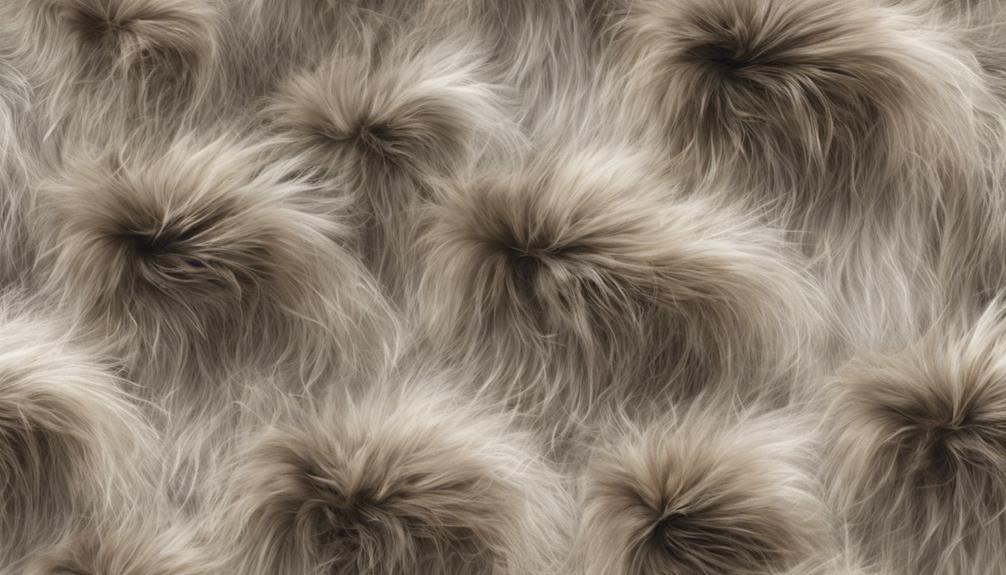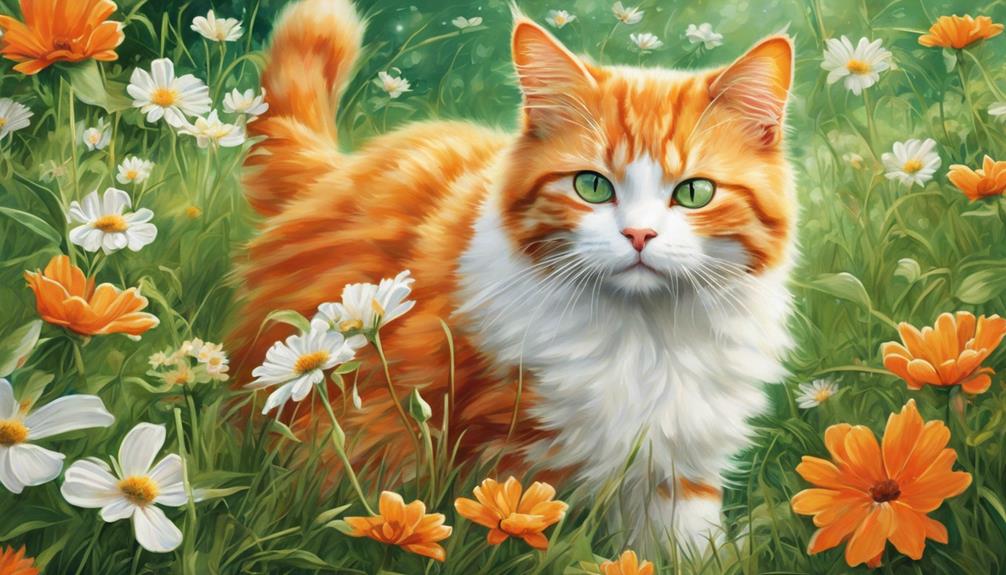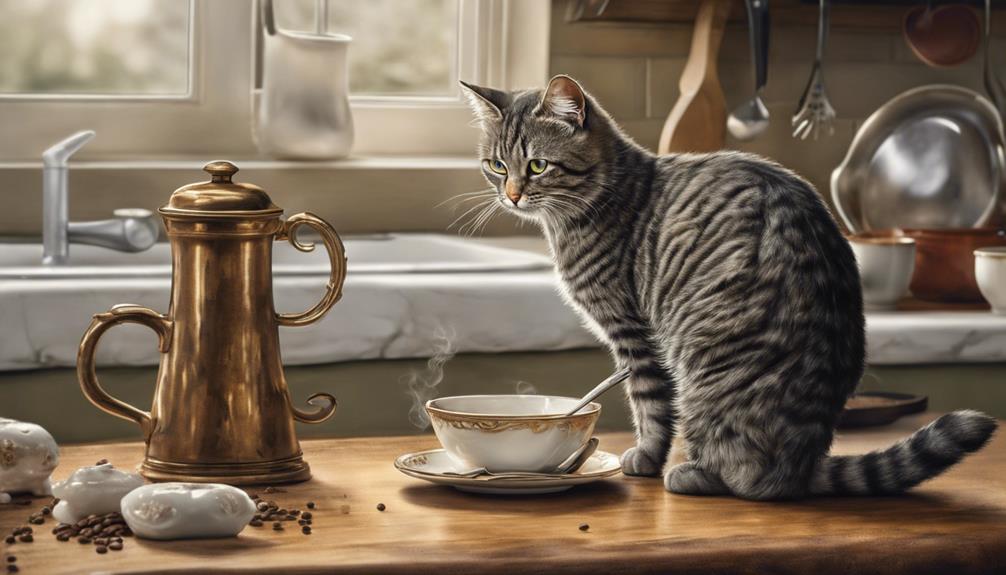Cats control their tails with precision, using them for communication, balance, and expressing feelings. The tail's anatomy includes caudal vertebrae that decrease in size towards the tip. Most movements are voluntary, showing emotions like fear or contentment. Injuries can lead to unintended twitches, impacting their overall well-being. Monitoring these movements can help in cat care. Understanding cues in tail movements aids in connecting with felines. Cat tail positions signal different moods. Observing tail behavior helps interpret a cat's emotions accurately. Their tail language is essential for social interactions. Subtle cues in cat tail movements strengthen the bond between cats and humans, enhancing communication.
Key Takeaways
- Cats control their tails voluntarily through the brain.
- Tail movements convey emotions like fear, contentment, or nervousness.
- Involuntary tail movements occur during deep sleep or reflex actions.
- Tail sensitivity aids in communication, balance, and interaction.
- Understanding tail cues is essential for interpreting cat behavior accurately.
Cat Tail Anatomy
Cat tails consist of 18-23 caudal vertebrae that decrease in size towards the tip, forming an essential part of a cat's anatomy. These tails play a critical role in a cat's life, not just as a fluffy adornment, but as a tool for communication and balance. Within the tail, nerves stemming from the spinal cord allow for a range of sensory and motor functions. This unique anatomical structure, separate from the spinal cord, enables cats to control their tails with precision.
Understanding the tail's anatomy sheds light on why cats can express themselves through tail movements. The bones, connective tissue, muscles, blood vessels, and fur in the tail contribute significantly to about 10% of a cat's total bones. This intricate design not only aids in balance but also serves as a means for cats to communicate their emotions.
Next, we'll explore how cats utilize this anatomy to exhibit voluntary tail movements.
Voluntary Tail Movements

Examining the intricate connection between a cat's brain and its tail reveals the fascinating domain of voluntary tail movements. Cats use their tails for various purposes, including balance, hunting, and communication. Here are some key points to ponder about voluntary tail movements:
- Most tail movements in cats are essential, meaning they're consciously controlled by the brain.
- Signals from the brain trigger specific tail movements by activating the muscles through nerves.
- Different tail actions can convey a range of emotions such as fear, nervousness, or contentment, providing insight into a cat's state of mind.
- Vital tail movements play a critical role in activities like hunting, where precise control over the tail is necessary for stealth and coordination.
- Understanding how cats use their tails voluntarily enhances our appreciation for the complexity of their communication and behavior.
Involuntary Tail Movements

Sometimes, cat tails may twitch involuntarily, especially during deep slumber or in response to reflex actions. Injuries, even those not directly affecting the tail, can also lead to unintended tail movements in our feline friends.
REM sleep might cause cats to unknowingly sway their tails, while external stimuli can trigger reflex movements.
Tail Twitching Behavior
During deep sleep or due to reflex actions, involuntary tail twitching in cats can be a sign of feline hyperesthesia syndrome. Cats may experience these involuntary movements for various reasons, including trauma, REM sleep, and external stimuli. Understanding why cats exhibit these behaviors can help us provide better care for our feline friends.
- Trauma or injuries can lead to unintentional tail twitching in cats.
- REM sleep may cause cats to move their tails unconsciously.
- External stimuli can trigger reflex movements in a cat's tail.
- Involuntary tail twitching can be a sign of feline hyperesthesia syndrome.
- Paying attention to these movements can help us monitor our cat's health and well-being effectively.
Tail Puffing Signals
When cats exhibit tail puffing signals, they're involuntarily communicating feelings of fear, agitation, or discomfort. Tail puffing is an involuntary movement that serves as a defensive mechanism in response to perceived danger or stress.
This behavior can also be a way for cats to appear larger and more threatening to potential threats. When you notice your feline friend puffing their tail, it's crucial to understand that they might be experiencing emotional distress or discomfort with a particular situation or individual.
Feeling in Cat Tails

Exploring the intricate sensitivity of cat tails reveals a fascinating aspect of feline physiology. Cats have sensory nerves in their tails that allow them to experience a significant range of touch sensations. These sensory nerves play an essential role in how cats perceive their environment and interact with the world around them.
Here are five key points to deepen your understanding:
- Feeling: Sensory nerves in a cat's tail help them feel different textures and pressures, enhancing their sensory experiences.
- Communication: The tail is a vital part of a cat's communication and body language, conveying emotions and intentions to others.
- Well-being: The sensitivity of their tails contributes to a cat's overall well-being, as it helps them navigate their surroundings safely.
- Interaction: Cats use their tails to interact with objects and other animals, showcasing their emotions and responses.
- Body Language: Through the sensitivity of their tails, cats express a wide range of emotions, from happiness to agitation, enriching their non-verbal communication skills.
Tail Movements and Emotions

Cats' tail movements serve as a window into their emotions, revealing insights into their feelings of fear, nervousness, or contentment. Most cat tail movements are essential for balance and communication. Through brain signals delivered via nerves, cats control their tails, expressing a wide range of emotions.
Involuntary tail movements can occur during deep sleep, reflex actions, or due to external stimuli, showcasing the intricate connection between nerves and emotions in our feline friends. These involuntary movements can be triggered by factors unrelated to the tail, impacting the tail's movement and revealing the complexity of cats' emotional responses.
Understanding these subtle cues in tail movements can help us connect better with our cats, providing us with a glimpse into their inner world. So, next time you see your cat's tail twitch or fluff up, remember that it might be expressing more than meets the eye, showing you a glimpse of their current emotional state.
Tail Wagging in Cats

Regularly observing a cat's tail wagging can provide essential insights into its comfort and well-being. When we pay close attention to how a cat's tail moves, we can better understand their emotions and needs. Here are some key points to help you decode your feline friend's tail language:
- Cats tail may move in different ways to communicate various feelings, such as excitement, fear, or irritation.
- Different Cat Tail positions can indicate whether your cat is feeling relaxed, alert, or agitated.
- Understanding how cats control their tails can give us clues about their overall mood and well-being.
- Tail language is a vital aspect of feline communication, often revealing insights that verbal cues may not convey.
- Moon says your cats use their tails to express themselves and interact with their environment in a unique way.
Tail Behavior Concerns

To better understand tail behavior concerns in cats, it's essential to recognize the varying signals that different tail movements can indicate. Involuntary tail movements, such as severe tail twitching, could be a red flag for feline hyperesthesia syndrome, a condition that warrants veterinary attention.
Tail flicking, on the other hand, may convey intentional or involuntary messages, reflecting the cat's current mood or state of mind. Additionally, tail chasing behavior in cats might stem from anxiety or compulsive behaviors, highlighting the importance of addressing underlying emotional issues.
Regular playtime and mental stimulation can help prevent boredom-related tail chasing, promoting a healthier feline lifestyle. Being attuned to these nuances in cat tail language can aid in early detection of potential health or behavioral concerns, ensuring our beloved feline friends receive the care and support they need to thrive.
Veterinarian Consultation
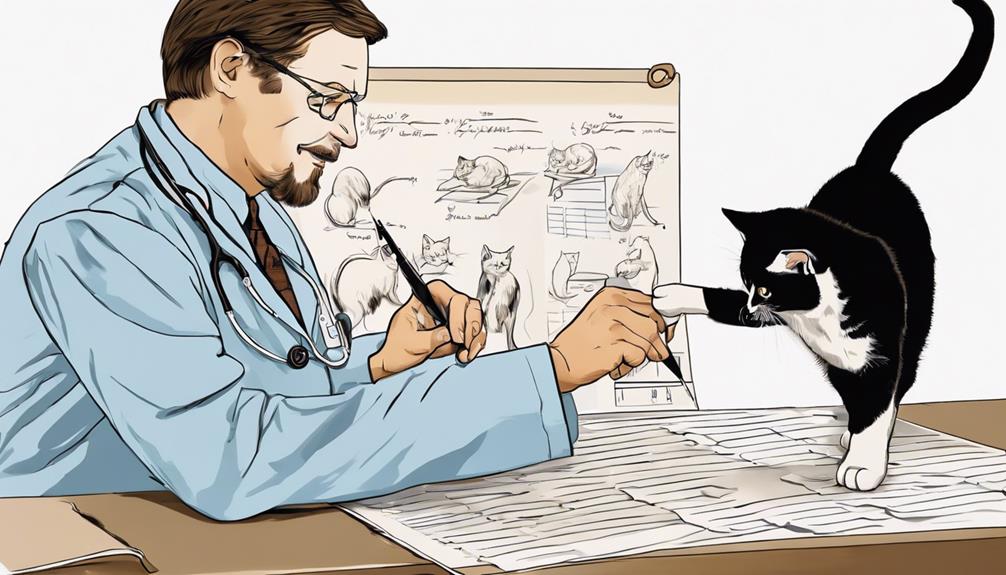
If you observe your cat exhibiting uncommon tail movements or behaviors, it's crucial to seek advice from a veterinarian. They can assist in identifying any hidden medical issues that could be impacting your cat's tail control.
Seeking professional guidance guarantees that your cat's tail movements are normal and addresses any possible concerns effectively.
Tail Movement Patterns
Cats can exhibit a variety of tail movement patterns that convey important information about their emotional state and overall well-being. Understanding these movements can give us valuable insights into our feline friends. Here are some key points to ponder:
- Tail movement is mostly voluntary and helps cats maintain balance.
- Voluntary tail movements originate in the brain, with nerves controlling the muscles.
- Involuntary tail movements can occur during deep sleep or in response to external stimuli.
- Severe tail twitching might indicate feline hyperesthesia syndrome, requiring veterinary attention.
- Different tail patterns can offer clues about a cat's emotions, allowing pet owners to better understand and care for their furry companions.
Communication Through Tail
When observing a cat's tail movements, it becomes evident that these gestures play a significant role in deciphering their emotional cues and intentions, prompting the need for veterinary consultation to guarantee ideal feline well-being.
Cats communicate through their tail by controlling its movements voluntarily. These tail movements reflect their emotions, helping them convey feelings like fear, nervousness, or contentment. Understanding how cats control their tails is essential for interpreting their behavior accurately.
Tail language not only expresses emotions but also aids in maintaining balance and engaging in social interactions. By paying attention to these subtle cues, we can enhance our communication with our feline companions and strengthen the bond we share. Veterinary guidance can further assist in ensuring our cats' physical and emotional health.
Tail Movements and Hyperesthesia

Understanding the nuances of tail movements in cats sheds light on the manifestation of hyperesthesia syndrome and its impact on feline behavior. When it comes to cat tail movements, voluntary control allows them to express emotions and maintain balance. However, involuntary twitching, especially severe and frequent, could signal feline hyperesthesia syndrome, leading to hypersensitivity and abnormal behavior. Such involuntary movements may cause discomfort or pain for the cat, indicating a need for veterinary attention to address potential underlying medical issues promptly.
Consulting a veterinarian is crucial if your cat displays intense or repetitive tail twitching, as it could be symptomatic of a more significant health problem. By recognizing the causes and implications of tail movements, including hyperesthesia, pet owners can ensure they provide the necessary care and support for their beloved feline companions.
- Voluntary control of tail movements expresses emotions and balance.
- Involuntary twitching may indicate feline hyperesthesia syndrome.
- Discomfort or pain could accompany involuntary tail movements.
- Veterinary attention is crucial for addressing potential underlying medical issues.
- Understanding tail movements helps pet owners provide appropriate care and support.
Tail Wagging and Moods

Exploring a cat's tail wagging behavior provides insights into their varying moods, including discomfort, pain, or excitement. When a feline flicks their tail rapidly or holds it low, it could signal that something is amiss, potentially indicating discomfort or pain. On the other hand, a tail held high with slight twitching might mean they're feeling frisky and excited.
These subtle cues can give us a glimpse into our furry friends' emotional state and help us provide the care they need. If you notice unusual tail behavior, such as excessive wagging or lack of movement, seeking veterinary advice is essential to safeguard your cat's well-being. Fetch Cat Insurance can lend a helping paw by covering veterinary exam costs related to concerns about your cat's tail behavior.
Aggression in Tail Movements

When observing cats, it's important to pay attention to their tail movements as they can reveal a lot about their emotional state.
Fast lashing tail movements often indicate aggression or a perceived threat towards a stimulus.
Cats may also exhibit fluffed up tails or twitching as warning signs when feeling irritated or uncomfortable.
Tail Signs of Aggression
In cats, aggressive behavior is often signaled through the fluffed up or rapidly moving tail, indicating a threat response. When observing your feline friend's tail, here are some key signs of aggression to look out for:
- Visibly agitated tail: A tail that appears puffed up or bristled can suggest heightened aggression levels.
- Rapid flicking: Quick side-to-side movements of the tail can be a warning sign of potential aggression.
- Aggressive thrashing: Violent thrashing of the tail indicates a high level of discomfort or displeasure in cats.
- Threat response: Tail behaviors like aggressive thrashing signal a defensive reaction to a perceived threat.
- Discomfort in cats: Cats may express their discomfort through aggressive tail movements, indicating a need for space or calming techniques.
Tail Puffing Behavior
During moments of heightened emotions such as fear or anger, cats display tail puffing behavior as a defensive response. When a cat's tail puffs up, it signifies aggression or agitation, showcasing the cat's emotional state. This defensive stance is often seen when a cat feels threatened or in a confrontational situation. By observing tail puffing behavior, we can gain insights into the cat's feelings and potentially prevent conflicts. Understanding these signals can help create a harmonious environment for both the cat and its human companions. Below is a table summarizing key points about tail puffing behavior in cats:
| Key Points | |
|---|---|
| Sign of Aggression | Yes |
| Indicates Emotions | Fear, Anger |
| Defensive Stance | Defensive Posture |
Tail Flicking Meaning
Cats often utilize tail flicking as a means of communication to express aggression or irritation. When observing your feline friend's tail flicking behavior, it's crucial to comprehend the deeper meanings behind it. Here are some key points to bear in mind:
- Tail flicking can be an indication of aggression or irritation.
- It's a typical behavior when a cat is feeling stressed or threatened.
- Rapid or vigorous tail flicking may suggest a higher level of agitation.
- Recognizing tail flicking can help avoid potential conflicts with your cat.
- Regard tail flicking as a warning sign to give your cat space and refrain from escalating the situation.
Understanding your cat's body language, particularly their tail movements, can nurture a harmonious relationship and cultivate a stress-free environment for both of you.
Playfulness in Tail Movements

Exhibiting a playful demeanor, cats express their excitement and engagement through gentle swishing or flicking of their tails in a curving motion resembling a question mark. This playful tail movement is a clear indicator of their mood and can vary in speed and intensity, reflecting their emotions and energy levels. When cats are feeling playful, their tails may twitch or flick as they interact with toys or chase after objects, showing their enthusiasm for the activity at hand. It's fascinating to observe how their tails become an extension of their playful spirit, adding an extra layer of charm to their already endearing behavior.
During playtime, if a cat starts to feel mildly annoyed or irritated, their tail movements might change subtly, signaling a shift in their mood. This nuanced communication through tail wagging is a demonstration of the complexity of feline behavior and highlights the importance of paying attention to the subtle cues our furry companions provide. Understanding these playful tail movements can deepen our bond with cats and enhance our ability to engage with them in a meaningful way.
Cat Tail Positions
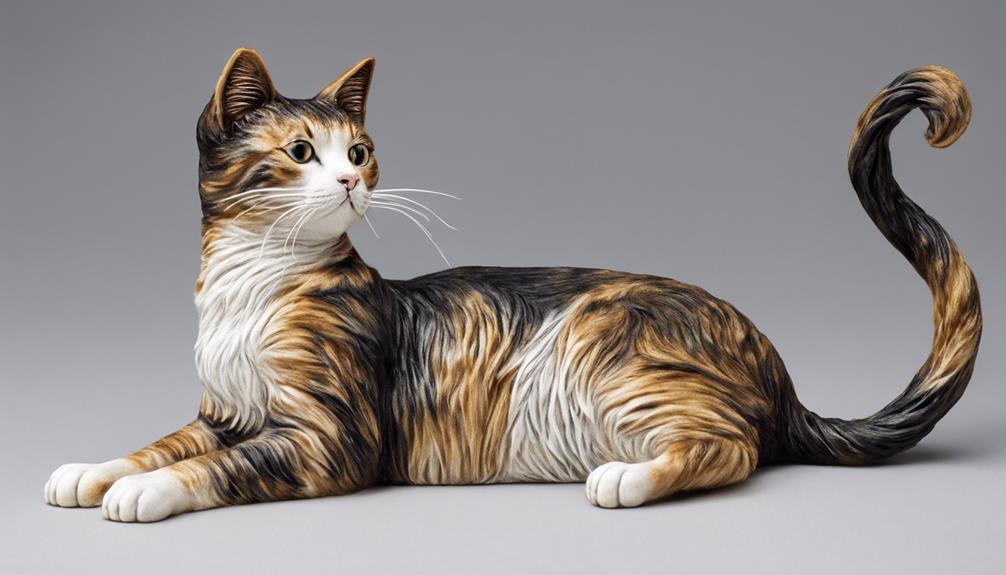
Swishing and flicking in various positions, cat tails serve as a visual language conveying a range of emotions and intentions. Understanding cat tail positions can provide valuable insights into our feline friends' feelings and behaviors.
Here are some key positions and their meanings:
- High Tail: A high tail with a slight curve indicates a happy cat seeking attention or play. It's a sign of confidence and contentment.
- Low Tail: When the tail points downward, it signifies a negative mood, fear, or submission. Cats may display this position when feeling threatened or anxious.
- Neutral Tail: A neutral tail held in line with the spine shows a cat in a neutral mood, being passively cautious, neither overly excited nor scared.
- Flicking Tail: An indication of a relaxed cat, a flicking tail can be either involuntary or deliberate. It can show a cat's playful or curious mood.
- Thrashing Tail: A thrashing tail, creating a thumping noise on the ground, indicates displeasure or discomfort. It's a clear sign that the cat is agitated or upset.
Observing these tail positions can help us better understand our feline companions and their behaviors.
Understanding Tail Movements

How do cats precisely coordinate their tail movements to express emotions and maintain balance?
Cat tail movements are primarily voluntary, with signals originating in the brain and traveling through nerves to command the tail muscles. The tail, composed of caudal vertebrae decreasing in size towards the tip, plays a vital role in activities such as balance, hunting, and communication.
These movements can convey a wide range of emotions, from fear and nervousness to contentment. While most tail movements are under the cat's control, involuntary movements can occur during deep sleep, as reflex reactions, or in response to external stimuli.
Injuries to the tail can potentially impact its function, affecting the cat's ability to communicate effectively and maintain balance. Understanding the intricate interplay between a cat's nerves, muscles, and bones in the tail provides insight into how these graceful creatures use their tails as a tool for both expression and physical stability.
Tail Movements and Communication

When observing cats, their tail movements serve as an essential form of communication that conveys a variety of emotions and messages to those around them. Cats use their tails to communicate feelings such as fear, nervousness, or contentment through voluntary actions controlled by commands from the brain to the tail muscles.
Tail actions like swishing, curling, or thrashing can indicate different moods or intentions in cats, enhancing their ability to express themselves. However, involuntary movements may occur during deep sleep, reflex actions, or in response to external stimuli, showing a more instinctual side of their communication.
Understanding these subtle cues in cat tail language can strengthen the bond between feline companions and their human friends, facilitating better communication and interaction. By paying attention to these intricate movements, we can decode the emotions and needs our cats are trying to convey, fostering a deeper connection with our furry friends.
Frequently Asked Questions
Do Cats Consciously Control Their Tails?
We communicate through our tails consciously. The brain commands our tail muscles through nerves, allowing us to express emotions like fear or contentment. Being aware of how we control our tails helps interpret our feelings accurately.
Why Do Cats Wag Their Tails While Lying Down?
Sometimes cats wag their tails while lying down to express discomfort or frustration. Paying attention to these subtle cues is crucial for their well-being. If you notice unusual tail movements, seek veterinary advice promptly.
Do Cats Know Their Tail Is Theirs?
We comprehend a cat's tail is theirs. Sensory nerves and brain connections confirm this. Cats control their tails voluntarily, showing awareness and ownership. Tail movements are brain-controlled, demonstrating recognition of their tails as part of themselves.
Why Do Cats Slap Their Tails?
We slap our tails to communicate feelings like affection or irritation. The force and speed vary, revealing different emotions. It can be a warning before aggression. Understanding tail slapping helps improve our relationship with humans and animals.
Conclusion
To sum up, cats do have some control over their tails, using them to communicate emotions and express playful behaviors. Understanding the movements of a cat's tail can provide insight into their feelings and intentions.
So next time you see your feline friend flicking their tail, pay attention to what they might be trying to tell you. Just like a wagging dog tail, a cat's tail can speak volumes if you know how to listen.

